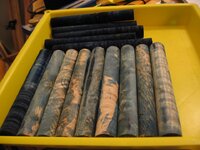pegasus70
Member
I have been experimenting with some curly maple blanks and wood dye to "pop" the grain and add some color to others. My problem is, every time I try this, the dye ends up very blotchy. I have been turning the blank and sanding to 400 grit then using an aniline dye dissolved in alcohol. Anyone with any ideas on how to prevent the blotchiness? Is there some pretreatment that might help?

